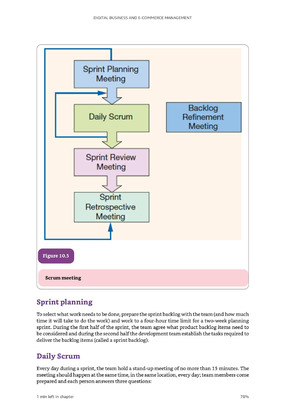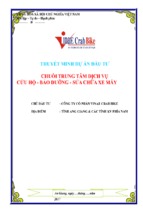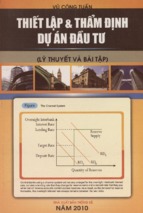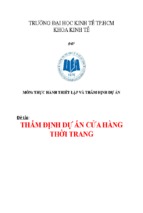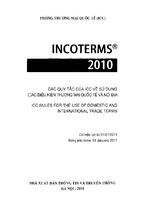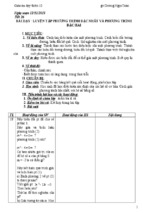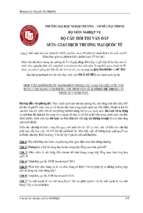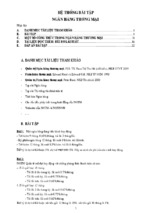Tài liệu được liệt kê trong danh sách tham khảo của PMI phục vụ cho chứng chỉ PMI-ACP
Introduction
This book could have been called Estimating and Planning Agile Projects. Instead, it’s called Agile Estimating and Planning. The difference may appear subtle but it’s not. The title makes it clear that the estimating and planning
processes must themselves be agile. Without agile estimating and planning, we
cannot have agile projects.
The book is mostly about planning, which I view as answering the question
of “what should we build and by when?” However, to answer questions about
planning we must also address questions of estimating (“How big is this?”) and
scheduling (“When will this be done?” and “How much can I have by then?”).
This book is organized in seven parts and twenty-three chapters. Each chapter ends with a summary of key points and with a set of discussion questions.
Since estimating and planning are meant to be whole team activities, one of the
ways I hoped this book would be read is by teams who could meet perhaps weekly
to discuss what they’ve read and could discuss the questions at the end of each
chapter. Since agile software development is popular worldwide, I have tried to
avoid writing an overly United States-centric book. To that end, I have used the
universal currency symbol, writing amounts such as ¤500 instead of perhaps
$500 or €500 and so on.
Part I describes why planning is important, the problems we often encounter, and the goals of an agile approach. Chapter 1 begins the book by describing
the purpose of planning, what makes a good plan, and what makes planning agile. The most important reasons why traditional approaches to estimating and
planning lead to unsatisfactory results are described in Chapter 2. Finally,
Chapter 3 begins with a brief recap of what agility means and then describes the
iii
iv
|
high-level approach to agile estimating and planning taken by the rest of this
book.
The second part introduces a main tenet of estimating, that estimates of size
and duration should be kept separate. Chapters 4 and 5 introduce story points
and ideal days, two units appropriate for estimating the size of the features to be
developed. Chapter 6 describes techniques for estimating in story points and
ideal days, and includes a description of planning poker. Chapter 7 describes
when and how to re-estimate and Chapter 8 offers advice on choosing between
story points and ideal days.
Part III, Planning For Value, offers advice on how a project team can make
sure they are building the best possible product. Chapter 9 describes the mix of
factors that need to be considered when prioritizing features. Chapter 10 presents an approach for modeling the financial return from a feature or feature set
and describes how to compare the returns from various items in order to prioritize work on the most valuable. Chapter 11 includes advice on how to assess and
then prioritize the desirability of features to a product’s users. Chapter 12 concludes this part with advice on how to split large features into smaller, more
manageable ones.
In Part IV, we shift our attention and focus on questions around scheduling
a project. Chapter 13 begins by looking at the steps involved in scheduling a relatively simple, single-team project. Next, Chapter 14 looks at at how to plan an
iteration. Chapters 15 and 16 look at how to select an appropriate iteration
length for the project and how to estimate a team’s initial rate of progress.
Chapter 17 looks in detail at how to schedule a project with either a high
amount of uncertainty or a greater implication to being wrong about the schedule. This part concludes with Chapter 18, which describes the additional steps
necessary in estimating and planning a project being worked on by multiple
teams.
Once a plan has been established, it must be communicated to the rest of the
organization and the team’s progress against it monitoried. These are the topics
of the three chapters of Part V. Chapter 19 looks specifically at monitoring the
release plan while Chapter 20 looks at monitoring the iteration plan. The final
chapter in this part, Chapter 21, deals specifically with communicating about
the plan and progress toward it.
Chapter 22 is the lone chapter in Part VI. This chapter argues the case for
why agile estimating and planning and stands as a counterpart to Chapter 2,
which described why traditional approaches fail so often.
Part VII, the final part, includes only one chapter. Chapter 23 is an extended
case study that reasserts the main points of this book but does so in a fictional
setting.
Acknowledgments
Acknowledgments
TBD--this will come later
tbd.
tbd.
.........
..........
........
tbd.......
|
v
vi
|
Part I
The Problem and The Goal
In order to present an agile approach to estimating and planning, it is important
to first understand the purpose of planning. This is the topic of the first chapter
in this part. Chapter 2 presents some of the most common reasons why traditionally planned projects frequently fail to result in on-time products that wow
their customers. The final chapter in this part then presents a high-level view of
the agile approach that is described throughout the remainder of the book.
1
2
|
Chapter 1
The Purpose of Planning
“Planning is everything. Plans are nothing.”
–Field Marshal Helmuth Graf von Moltke
Estimating and planning are critical to the success of any software development
project of any size or consequence. Plans guide our investment decisions: we
might initiate a specific project if we estimate it to take six months and $1 million but would reject the same project if we thought it would take two years and
$4 million. Plans help us know who needs to be available to work on a project
during a given period. Plans help us know if a project is on track to deliver the
functionality that users need and expect. Without plans we open our projects to
any number of problems.
Yet, planning is difficult and plans are often wrong. Teams often respond to
this by going to one of two extremes: they either do no planning at all or they put
so much effort into their plans that they become convinced that the plans must
be right. The team that does no planning cannot answer the most basic questions such as “When will you be done?” and “Can we schedule the product release for June?” The team that over-plans deludes themselves into thinking that
any plan can be “right.” Their plan may be more thorough but that does not necessarily mean it will be more accurate or useful.
That estimating and planning are difficult is not news. We’ve known it for a
long time. In 1981, Barry Boehm drew the first version of what Steve McConnell
(1998) later called the “cone of uncertainty.” Figure 1.1 shows Boehm’s initial
ranges of uncertainty at different points in a sequential development (“waterfall”) process. The cone of uncertainty shows that during the feasibility phase of
3
4
|Chapter 1
The Purpose of Planning
a project a schedule estimate is typically as far off as 60% to 160%. That is, a
project expected to take 20 weeks could take anywhere from 12 to 32 weeks. After the requirements are written, the estimate might still be off +/- 15% in either
direction. So an estimate of 20 weeks means work that takes from 17 to 23
weeks.
Project
Schedule
1.6x
1.25x
1.15x
1.10x
x
0.9x
0.85x
0.8x
0.6x
Initial
Product
Definition
Approved
Product
Definition
Requirements
Specification
Product
Design
Specification
Detailed
Design
Specification
Accepted
Software
Figure 1.1 The cone of uncertainty narrows as the project progresses.
The Project Management Institute (PMI) presents a similar view on the progressive accuracy of estimates. However, rather than viewing the cone of uncertainty as symmetric, they view it as asymmetric. They suggest the creation of an
initial order of magnitude estimate, which ranges from +75% to -25%. The next
estimate to be created is the budgetary estimate, with a range of +25% to -10%,
followed by the final definitive estimate, with a range of +10% to -5%.
Why Do It?
If estimating and planning are difficult, and if it’s impossible to get an accurate
estimate until so late in a project, why do it at all? Clearly, there is the obvious
reason that the organizations in which we work often demand that we provide
estimates. Plans and schedules may be needed for a variety of legitimate reasons
such as planning marketing campaigns, scheduling product release activities,
training internal users, and so on. These are important needs and the difficulty
of estimating a project does not excuse us from providing a plan or schedule that
Reducing Uncertainty
|
the organization can use for these purposes. However, beyond these perfunctory
needs, there is a much more fundamental reason to take on the hard work of estimating and planning.
Estimating and planning are not just about determining an appropriate
deadline or schedule. Planning—especially an ongoing iterative approach to
planning—is a quest for value. Planning is an attempt to find an optimal solution to the overall product development question: What should we build? To answer this question, the team considers features, resources, and schedule. The
question cannot be answered all at once. It must be answered iteratively and incrementally. At the start of a project we may decide that a product should contain a specific set of features and be released on August 31. But in June we may
decide that a slightly later date with slightly more features will be better. Or we
may decide that slightly sooner with slightly fewer features will be better.
A good planning process supports this by:
◆
Reducing risk
◆
Reducing uncertainty
◆
Supporting better decision making
◆
Establishing trust
◆
Conveying information
Reducing Risk
Planning increases the likelihood of project success by providing insights into
the project’s risks. Some projects are so risky that we may choose not to start
once we’ve learned about the risks. Other projects may contain features whose
risks can be contained by early attention.
The discussions that occur while estimating raise questions that expose potential dark corners of a project. For example, suppose you are asked to estimate
how long it will take to integrate the new project with an existing mainframe
legacy system that you know nothing about. This will expose the integration features as a potential risk. The project team can opt to eliminate the risk right
then by spending time learning about the legacy system. Or the risk can be noted
and the estimate for the work either made larger or expressed as a range to account for the greater uncertainty and risk.
Reducing Uncertainty
Throughout a project, the team is generating new capabilities in the product.
They are also generating new knowledge—about the product, the technologies
5
6
|Chapter 1
The Purpose of Planning
in use, and themselves as a team. It is critical that this new knowledge be acknowledged and factored into an iterative planning process that is designed to
help a team refine their vision of the product. The most critical risk facing most
projects is the risk of developing the wrong product. Yet, this risk is entirely ignored on most projects. An agile approach to planning can dramatically reduce
(and hopefully eliminate) this risk.
The often-cited CHAOS studies (Standish 2001) define a successful project
as on time, on budget, and with all originally specified features. This is a dangerous definition because it fails to acknowledge that a feature that looked good
when the project was started may not be worth its development cost once the
team begins on the project. If I were to define a failed project, one of my criteria
would certainly be “a project on which no one came up with any better ideas
than what was on the initial list of requirements.” We want to encourage
projects on which investment, schedule, and feature decisions are periodically
reassessed. A project that delivers all features on the initial plan is not necessarily a success. The product’s users and customer would probably not be satisfied if
wonderful new feature ideas had been rejected in favor of mediocre ones simply
because the mediocre features were in the initial plan.
Supporting Better Decision Making
Estimates and plans help us make decisions. How does an organization decide if
a particular project is worth doing if it does not have estimates of the value and
the cost of the project? Beyond decisions about whether or not to start a project,
estimates help us make sure we are working on the most valuable projects possible. Suppose an organization is considering two projects, one is estimated to
make $1 million and the second is estimated to make $2 million. First, the organization needs schedule and cost estimates in order to determine if these
projects are worth pursuing. Will the projects take so long that they miss a market window? Will the projects cost more than they’ll make? Second, the organization needs estimates and a plan so that they can decide which to pursue. The
company may be able to pursue one project, both projects, or neither if the costs
are too high.
Organizations need estimates in order to make decisions beyond whether or
not to start a project. Sometimes the staffing profile of a project can be more important than its schedule. For example, a project may not be worth starting if it
will involve the time of the organization’s chief architect, who is already fully
committed on another project. However, if a plan can be developed that shows
how to complete the new project without the involvement of this architect then
the project may be worth starting.
Conveying Information
|
Many of the decisions made while planning a project are tradeoff decisions.
For example, on every project we make tradeoff decisions between development
time and cost. Often the cheapest way to develop a system would be to hire one
good programmer and allow her ten or twenty years to write the system, allowing her years of detouring to perhaps master the domain, become an expert in
database administration, and so on. Obviously though, we can rarely wait twenty
years for a system and so we engage teams. A team of thirty may spend a year
(thirty person-years) developing what a lone programmer could have done in
twenty. The development cost goes up but the value of having the application
nineteen years earlier justifies the increased cost.
We are constantly making similar tradeoff decisions between functionality
and effort, cost, and time. Is a particular feature worth delaying the release?
Should we hire one more developer so that a particular feature can be included
in the upcoming release? Should we release in June or hold off until August and
have more features? Should we buy this development tool? In order to make
these decisions we need estimates of both the costs and benefits.
Establishing Trust
Frequent reliable delivery of promised features builds trust between the developers of a product and the customers of that product. Reliable estimates enable reliable delivery. A customer needs estimates in order to make important
prioritization and tradeoff decisions. Estimates also help a customer decide how
much of a feature to develop. Rather than investing twenty days and getting everything, perhaps ten days of effort will yield 80% of the benefit. Customers are
reluctant to make these types of tradeoff decisions early in a project unless the
developers’ estimates have proven trustworthy.
Reliable estimates benefit developers by allowing them to work at a sustainable pace. This leads to higher quality code and fewer bugs. These, in turn, lead
back to more reliable estimates because less time is spent on highly unpredictable work such as bug fixing.
Conveying Information
A plan conveys expectations and describes one possibility of what may come to
pass over the course of a project. A plan does not guarantee an exact set of features on an exact date at a specified cost. A plan does, however, communicate
and establish a set of baseline expectations. Far too often a plan is reduced to a
single date and all of the assumptions and expectations that led to that date are
forgotten.
7
8
|Chapter 1
The Purpose of Planning
Suppose you ask me when a project will be done. I tell you seven months but
provide no explanation of how I arrived at that duration. You should be skeptical
of my estimate. Without additional information you have no way of determining
whether I’ve thought about the question sufficiently or whether my estimate is
realistic.
Suppose, instead, that I provide you with a plan that estimates completion in
seven to nine months, shows what work will be completed in the first one or two
months, documents key assumptions, and establishes an approach for how we’ll
collaboratively measure progress. In this case you can look at my plan and draw
conclusions about the confidence you should have in it.
What Makes a Good Plan?
A good plan is one that stakeholders find sufficiently reliable that they can use it
as the basis for making decisions. Early in a project, this may mean that the plan
says that the product can be released in the third quarter, rather than the second, and that it will contain approximately a described set of features. Later in
the project, in order to remain useful for decision making, this plan will need to
be more precise.
For example, suppose you are estimating and planning a new release of the
company’s flagship product. You determine that the new version will be ready for
release in six months. You create a plan that describes a set of features that are
certain to be in the new version and another set of features that may or may not
be included, depending on how well things progress.
Others in the company can use this plan to make decisions. They can prepare marketing materials, schedule an advertising campaign, allocate resources
to assist with upgrading key customers, and so on. This plan is useful—as long
as it is somewhat predictive of what actually happens on the project. If development takes twelve months, instead of the planned six, then this was not a good
plan.
However, if the project takes seven months instead of six, the plan was probably still useful. Yes, the plan was incorrect and yes it may have led to some
slightly mistimed decisions. But a seven month delivery of an estimated sixmonth project is generally not the end of the world and is certainly within the
PMI’s margin of error for a budgetary estimate. The plan, although inaccurate,
was even more likely useful if we consider that it should have been updated regularly throughout the course of the project. In that case, the one-month late delivery should not have been a last-minute surprise to anyone.
- Xem thêm -


